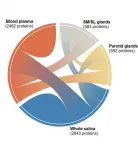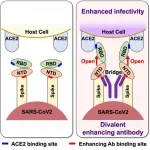"Bite" defects in bottom-up graphene nanoribbons
Quantum electronics
2021-05-25
(Press-News.org) Graphene nanoribbons (GNRs), narrow strips of single-layer graphene, have interesting physical, electrical, thermal, and optical properties because of the interplay between their crystal and electronic structures. These novel characteristics have pushed them to the forefront in the search for ways to advance next-generation nanotechnologies.
While bottom-up fabrication techniques now allow the synthesis of a broad range of graphene nanoribbons that feature well-defined edge geometries, widths, and heteroatom incorporations, the question of whether or not structural disorder is present in these atomically precise GNRs, and to what extent, is still subject to debate. The answer to this riddle is of critical importance to any potential applications or resulting devices.
Collaboration between Oleg Yazyev's Chair of Computational Condensed Matter Physics theory group at EPFL and Roman Fasel's experimental nanotech@surfaces Laboratory at Empa has produced two papers that look at this issue in armchair-edged and zigzag-edged graphene nanoribbons.
"In these two works, we focused on characterizing "bite-defects" in graphene nanoribbons and their implications on GNR properties", explains Gabriela Borin Barin from Empa's nanotech@surfaces lab. "We observed that even though the presence of these defects can disrupt GNRs' electronic transport, they could also yield spin-polarized currents. These are important findings in the context of the potential applications of GNRs in nanoelectronics and quantum technology."
Armchair graphene nanoribbons
The paper "Quantum electronic transport across "bite" defects in graphene nanoribbons," recently published in 2D Materials, specifically looks at 9-atom wide armchair graphene nanoribbons (9-AGNRs). The mechanical robustness, long-term stability under ambient conditions, easy transferability onto target substrates, scalability of fabrication, and suitable band-gap width of these GNRs has made them one of the most promising candidates for integration as active channels in field-effect transistors (FETs). Indeed, among the graphene-based electronic devices realized so far, 9-AGNR-FETs display the highest performance.
While the detrimental role of defects on electronic devices is well known, Schottky barriers, potential energy barriers for electrons formed at metal-semiconductor junctions, both limit the performance of current GNR-FETs and prevent experimental characterization of the impact of defects on device performance. In the 2D Materials paper, the researchers combine experimental and theoretical approaches to investigate defects in bottom-up AGNRs.
Scanning-tunnelling and atomic-force microscopies first allowed the researchers to identify missing benzene rings at the edges as a very common defect in 9-AGNRs and to estimate both the density and spatial distribution of these imperfections, which they have dubbed "bite" defects. They quantified the density and found that they have a strong tendency to aggregate. The researchers then used first-principles calculations to explore the effect of such defects on quantum charge transport, finding that these imperfections significantly disrupt it at the band edges by reducing conductance.
These theoretical findings are then generalized to wider nanoribbons in a systematic manner, allowing the researchers to establish practical guidelines for minimizing the detrimental role of these defects on charge transport, an instrumental step towards the realization of novel carbon-based electronic devices.
Zigzag graphene nanoribbons
In the paper "Edge disorder in bottom-up zigzag graphene nanoribbons: implications for magnetism and quantum electronic transport," recently published in the Journal of Physical Chemistry Letters, the same team of researchers combines scanning probe microscopy experiments and first-principles calculations to examine structural disorder and its effect on magnetism and electronic transport in so-called bottom-up zigzag GNRs (ZGNRs).
ZGNRs are unique because of their unconventional metal-free magnetic order that, according to predictions, is preserved up to room temperature. They possess magnetic moments that are coupled ferromagnetically along the edge and antiferromagnetically across it and it has been shown that the electronic and magnetic structures can be modulated to a large extent by, for example, charge doping, electric fields, lattice deformations, or defect engineering. The combination of tunable magnetic correlations, sizable band gap width and weak spin?orbit interactions has made these ZGNRs promising candidates for spin logic operations. The study specifically looks at six-carbon zigzag lines wide graphene nanoribbons (6-ZGNRs), the only width of ZGNRs that has been achieved with a bottom-up approach so far.
Again using scanning-tunnelling and atomic-force microscopies, the researchers first identify the presence of ubiquitous carbon vacancy defects located at the edges of the nanoribbons and then resolve their atomic structure. Their results indicate that each vacancy comprises a missing m-xylene unit, that is, another "bite" defect, which, as with those seen in AGNRs, comes from the scission of the C?C bond that occurs during the cyclodehydrogenation process of the reaction. Researchers estimate the density of "bite" defects in the 6-ZGNRs to be larger than that of the equivalent defects in bottom-up AGNRs.
The effect of these bite defects on the electronic structure and quantum transport properties of 6-ZGNRs is again examined theoretically. They find that the introduction of the defect, similarly to AGNRs, causes a significant disruption of the conductance. Furthermore, in this nanostructure, these unintentional defects induce sublattice and spin imbalance, causing a local magnetic moment. This, in turn, gives rise to spin-polarized charge transport that makes defective zigzag nanoribbons optimally suited for applications in all-carbon logic spintronics in the ultimate limit of scalability.
A comparison between ZGNRs and AGNRs of equal width shows that transport across the former is less sensitive to the introduction of both single and multiple defects than in the latter. Overall, the research provides a global picture of the impact of these ubiquitous "bite" defects on the low-energy electronic structure of bottom-up graphene nanoribbons. Future research might focus on the investigation of other types of point defects experimentally observed at the edges of such nanoribbons, the researchers said.
INFORMATION:
ELSE PRESS RELEASES FROM THIS DATE:
2021-05-25
In the latest National Autism Indicators Report, researchers from Drexel University’s A.J. Drexel Autism Institute examined surveys of family members of autistic adults who use Developmental Disability services, and found needs for additional supports like respite care and assistance to plan for crisis and emergencies, especially among families whose adult lived with them.
Data from the surveys showed over one quarter of families with autistic adults who use Developmental Disability services and live with family do not have enough services or supports for themselves, according to the report. And over half of these families ...
2021-05-25
Staying up all night, working nonstop, eating on the run and skipping meals are often telltale signs of starting a new business. But research shows this constant hustle - which is often glorified as the key to success - can have a negative impact not only on an entrepreneur's health and well-being but also his or her business.
New research led by UCF assistant professor of management Jeff Gish suggests that engaging in recovery may help entrepreneurs reduce the negative impact of stress.
"Entrepreneurs who work really hard and grind on their business and who most ...
2021-05-25
Cells sense and respond to the mechanical properties of the cellular microenvironment in the body. Changes in these properties, which occur in a number of human pathologies, including cancer, can elicit abnormal responses from cells. How the cells adapt to such changes in the mechanical microenvironment is not well understood.
A team of researchers at Texas A&M University are working to understand cellular mechanosensing -- the ability to sense and respond to the mechanical properties of the microenvironment -- in a unique way. Dr. Tanmay Lele, Unocal Professor in the Department of Biomedical Engineering, Department of Chemical Engineering and the Department of Translational Medical Sciences, partnered with Dr. Charles Baer, an evolutionary biologist at the University of Florida. ...
2021-05-25
BUFFALO, N.Y. - To improve the development of new saliva-based diagnostic tests and personalized medicine, the National Institute of Dental and Craniofacial Research (NIDCR) has supported the development of the Human Salivary Proteome Wiki, the first public platform that catalogs and curates data on each of the thousands of proteins within our saliva.
Detailed in an article published on Tuesday, May 25 in the Journal of Dental Research, the wiki provides researchers and clinicians with rich, unbiased evidence from multiple independent studies to help explore the dynamic and complex nature of saliva, as well as analytical tools to search for data by tissue type, disease and more.
"This ...
2021-05-25
New effective compounds, which can be endogenous donors of a signaling molecule - hydrogen sulfide in the body, were synthesized by SUSU scientists. Due to this property, the obtained compounds are potential drugs with a cancer-preventing effect. The research work was published in the Russian Chemical Bulletin (Q3).
Organosulfur compounds with anticancer, antibacterial, and antirheumatic properties have been studied for some years by scientists from South Ural State University and N.D. Zelinsky Institute of Organic Chemistry, Russian Academy of Sciences. In the latest study, they attempted to search for new derivatives of 1,2-dithiol-3-thiones - compounds with various ...
2021-05-25
Scientists from the UK's University of Bath explore racemases - an important type of enzyme that is linked to certain cancers and other life-threatening diseases while also being critical to cell function - in a paper published in the prestigious journal Chemical Society Reviews. The scientists also propose new strategies for finding drugs that neutralise these enzymes.
Many racemases and epimerases perform vital roles in human and animal cells, and in disease-causing organisms. They facilitate proper nerve function, the degradation of toxic substances, the formation of bacterial cell walls and the conversion of certain drugs into their active ...
2021-05-25
Alzheimer's disease is the main cause of dementia and current therapeutic strategies cannot prevent, slow down or cure the pathology. The disease is characterized by memory loss, caused by the degeneration and death of neuronal cells in several regions of the brain, including the hippocampus, which is where memories are initially formed. Researchers from the Netherlands Institute for Neuroscience (NIN) have identified a small molecule that can be used to rejuvenate the brain and counteract the memory loss.
New cells in old brains
The presence of adult-born cells in the hippocampus ...
2021-05-25
A research group from Osaka University led by Professor Hisashi Arase and consisting of researchers from the Research Institute for Microbial Diseases, the Institute for Protein Research, the Immunology Frontier Research Center, the Center for Infectious Diseases, and the Graduate School of Medicine has discovered for the first time that both neutralizing antibodies that protect against infection as well as infection-enhancing antibodies that increase infectivity are produced after infection with SARS-CoV-2 by analyzing antibodies derived from COVID-19 patients.
Antibodies against the receptor binding site (RBD) of the SARS-CoV-2 spike protein play an important function as ...
2021-05-25
UNIVERSITY PARK, Pa. -- A new map of dark matter in the local universe reveals several previously undiscovered filamentary structures connecting galaxies. The map, developed using machine learning by an international team including a Penn State astrophysicist, could enable studies about the nature of dark matter as well as about the history and future of our local universe.
Dark matter is an elusive substance that makes up 80% of the universe. It also provides the skeleton for what cosmologists call the cosmic web, the large-scale structure of the universe ...
2021-05-25
WASHINGTON (May 25, 2021)--A new report summarizes the findings from a national survey of frontline health care workers during the early days of the COVID-19 pandemic, finding that many reported unsafe working conditions and retaliation for voicing their concerns to employers. The survey, launched in May 2020 by staff and student researchers at the George Washington University, provides a snapshot of the experiences of frontline health care workers providing care for millions of Americans during the pandemic.
"This survey gives a voice to US health care workers who have been on the frontlines ...
LAST 30 PRESS RELEASES:
[Press-News.org] "Bite" defects in bottom-up graphene nanoribbons
Quantum electronics



